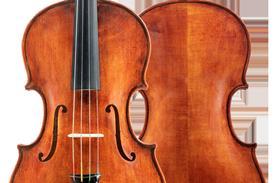- More from navigation items
- Home
- News
- For Subscribers
- Student Hub
- Playing Hub
- Podcast
- Lutherie
- Magazine
- Magazine archive
- Whether you're a player, maker, teacher or enthusiast, you'll find ideas and inspiration from leading artists, teachers and luthiers in our archive which features every issue published since January 2010 - available exclusively to subscribers. View the archive.
- Jobs
- Shop
- Directory
- Contact us
- Subscribe
- Competitions
- Reviews
- Debate
- Artists
- Accessories
Wood treatment: The magic touch

New research has revealed how Stradivari, Amati and Guarneri ‘del Gesù’ all used tonewood that had been heavily treated with chemicals prior to carving. Wenjie Cai and Hwan-Ching Tai explain the study’s findings, and suggest it could indicate that the Cremonese makers were influenced by the contemporary alchemical beliefs
For centuries, luthiers have speculated that the master Cremonese makers may have subjected the spruce and maple they worked with to some kind of modification before using it to make an instrument. The most common belief is that it was simply dried in the air for 5 to 20 years, but many other scenarios have been proposed, including: treatment with acid or alkali; baking; freezing; boiling; chemical baths; and floating the wood in rivers, ponds, lagoons or even oceans. These speculations arose partly because makers needed to account for the thinness of soundboards used by Stradivari and Guarneri ‘del Gesù’, which can average around 2.4mm in the centre, as opposed to 2.9–3.5mm in modern instruments. There were some who asserted that modern soundboards could be made as thin, while others were concerned about unbalanced tone and long-term risk of cracking. These debates have inspired scientists to analyse Cremonese wood shavings, collected during repairs, to look for unusual traits.
In 1984 researcher Joseph Nagyvary examined shavings from the top of an Andrea Guarneri cello, and reported finding a concentration of aluminium that reached 700ppm (parts per million), compared with less than 10ppm in natural spruce. In 2013 we began a research project in collaboration with Nagyvary, Brigitte Brandmair, the Chimei Museum and restorers around the world, to investigate the material properties of Cremonese soundboards. We used a wide range of spectroscopic, microscopic and chemical techniques, and found similar types of spruce in Cremonese soundboards as in modern instruments – but the Cremonese spruces exhibited unnatural elemental compositions and oxidation patterns that suggested artificial manipulation. This article will examine the findings of this study in depth, and also explore the possibility that the early Cremonese luthiers were influenced in their search for the optimum tonewood treatment by the alchemical researches of the city’s apothecaries…
Already subscribed? Please sign in
Subscribe to continue reading…
We’re delighted that you are enjoying our website. For a limited period, you can try an online subscription to The Strad completely free of charge.
* Issues and supplements are available as both print and digital editions. Online subscribers will only receive access to the digital versions.




























